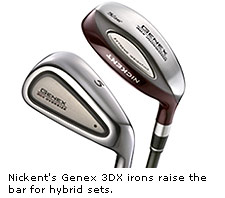 PRODUCT REVIEW
PRODUCT REVIEW Nickent Genex
3DX Irons: In the
nick of time for 2004
By Kiel Christianson,
Senior Writer
BOSTON (Jan. 10, 2004) – Over the last few years, the two big themes when it comes to irons have been the resurgence of forged blades (or semi-blades) at one extreme, and the introduction of hybrid sets at the other extreme. The former are aimed at single-digit (or single-digit wannabe) players, while the latter are aimed at the other 95 percent of golfers. In 2004, the hybrid iron is coming into its own as more than just a band-aid for high handicappers.
At the top of the hybrid class is the Genex 3DX by Nickent Golf, a highly respected component company founded in 1995 that has recently – and impressively – begun producing entire clubs for retail sale.
What sets the Nickent Genex 3DX apart from other hybrids is that the Genex was designed and engineered from start to finish as a hybrid set. The Genex ironwoods (starting with either the 6-, 5-, or 4-ironwood, depending on your preference) are not replacement clubs for traditional irons, as is the case with other hybrid sets. As such, the progression of shaft length, weighting, off-set, and loft flow seamlessly all the way up from the 55-degree sand wedge to the 17-degree 2-ironwood.
The result is a visually appealing - sexy, even - set of sticks. The weighting system is called Extreme 3D Weighting, referring to a three-dimensional hollow cast, with weight in all lofts moved lower, deeper, and toward the heel. Combined with the progressive offset, this weighting makes these irons and ironwoods very difficult to slice.
How They Play
Before the snow flew in New England, I took the Genex 3DX irons (graphite shaft with both iron and ironwood versions of the 6- and 5-irons) out to the range and swung them first myself. The iron heads have quite wide top-lines, and at address look nothing like my usual irons. My first swings were far too fast, and the weighting and offset (combined with my handsy swing) produced some wicked hooks. Once I slowed my swing down, though, the ball literally rocketed off the face of every club, from sand wedge up through 2-ironwood, which I was belting nearly as far as my driver that day. In fact, I realized that on the course the main trouble would be hitting the ball TOO FAR. I’m not used to hitting 200-yard 5-irons.
On a subsequent 18-hole round, I lent the Genex 3DX set to a high-teens handicap playing partner who swings smooth but fast. He, too, had to slow down his swing, and when he did, the results were spectacular. The 17-degree 2-ironwood soon replaced his driver off the tee. He found that 260 yards was shorter than he was used to with the big stick, but 260 in the fairway is better any day than 290 yards O.B.
Finally, following warmer temperatures to Philly for a Thanksgiving Day round and Indy for a Christmas Day round, I lent the set to a mid-20s handicap senior who can still bust it off the tee, but has always struggled with iron play. His first swing in Philly was from a lousy lie in the rough, resulting in a perfect high draw around trees to the middle of the par-5’s fairway. In both rounds, his only complaint was that he was hitting the clubs so far and so straight that the ball kept rolling through the greens. Poor guy.
Who They’re For
First, who the Nickent Genex 3DX are not for. If you’re a low-handicap player who likes a thin top-line and fine-tuned workability, why are you even reading about a hybrid set, anyway?
Who these very solid clubs are for are mid- to high-handicappers who are looking for greater forgiveness, playability, or length in their irons (and off the tee, as well). The sets come in either steel ($599) or graphite ($699) shafts. The former are ideal for better players who want forgiveness but are not so concerned with distance. The latter are ideal for players looking for distance along with playability. Graphite shafts are also excellent for seniors with arthritis and seniors or ladies (ladies sets are available) who might be looking to increase clubhead speed and, consequently, length.
In taking the hybrid iron set to a new level, Nickent has succeeded in making clubs that are not only longer, but easier to control. A rare accomplishment, indeed.
For more information, see www.nickentgolf.com
Any opinions expressed above are those of the writer and do not necessarily represent the views of the management. The information in this story was accurate at the time of publication. All contact information, directions and prices should be confirmed directly with the golf course or resort before making reservations and/or travel plans.
 PRODUCT REVIEW
PRODUCT REVIEW PRODUCT REVIEW
PRODUCT REVIEW